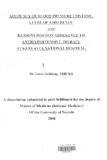Adequency of blood pressure control, level of adherence and reasons for non adherence to antihypertensive therapy at Kenyatta National Hospital.
Abstract
Hypertension is a common cardiovascular risk factor in Sub Saharan Africa and is associated with high morbidity and mortality. However, it is often insufficiently controlled in clinical practice, a prominent reason for this being poor patient adherence to
prescribed therapy.
Little is known about control, adherence, and the underlying reasons for poor adherence in our set up.
The study was designed to investigate the adequacy of blood pressure control, level of adherence to prescribed therapy and the patient perceived reasons for non adherence.
This was a cross-sectional descriptive study, it was carried out in two parts; quantitative methods were used to analyse adequacy ofBP control and level of adherence to antihypertensive therapy, and qualitative methods were used to analyse the patient
reasons for non adherence.
BP control was assessed using clinic BP measurement; adherence was assessed using the HB questionnaire and a qualitative analysis of in-depth interviews with non adherent patients was carried out.
Two hundred and sixty four patients participated in the quantitative arm of the study, sixty eight (26%) were found to have adequate BP control. Of those who had poor blood pressure control, defined as UP 2:140190 mmllg, one hundred and fourteen (58.5%) had 131' of:::: 160/1 001lJ1lll1g.
Poor DP control was significantly associated with non adherence (p=0.006, (2=0.54 for systolic BP, 0.63 for diastolic BP), obesity (p=0.03), and increasing number of medication (p=0.012 for diastolic BP and 0.038 for systolic BP). Other causes of poor BP control included suboptimal therapy and lack oflifestyle modification.
Eighty four (31.8%) of the patients were fully adherent to antihypertensive therapy. Non adherence was not significantly associated with any socia-demographic factors. 37.3% of patients who were adherent had good BP control compared to 20.8% of those who were non adherent (p=0.005). Of the patients who were fully adherent to therapy yet had poor DP control, 86.3% were on suboptimal therapy.
12 patients were recruited into the qualitative arm of the study. The patient perceived reasons for non adherence were: high cost of drugs, unavailability of drugs, competing altemative therapies including herbal therapy and prayer, convenience, side effects of the medication, relief of symptoms, fear 0 f low blood pressure, conflicting information from heath care providers, and due to poor understanding of hypertension and its management
modalities.
There was poor UP control in our population, largely due to non adherence. The in-depth interview identified patients' reasons for non adherence and solutions to these problems should be adopted in programmes to improve adherence with antihypertensive medication and blood pressure control.
Publisher
University of Nairobi
Description
(data migrated from the old repository)

